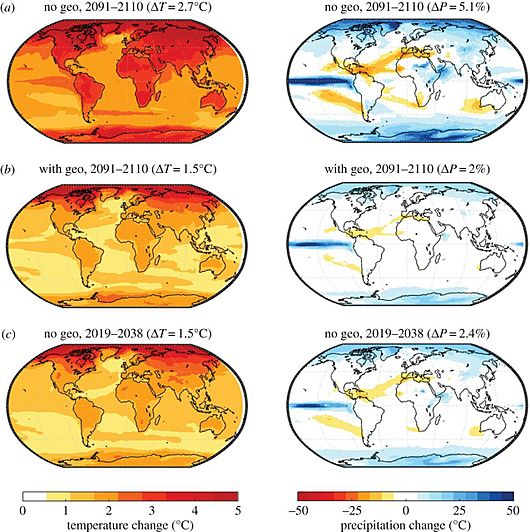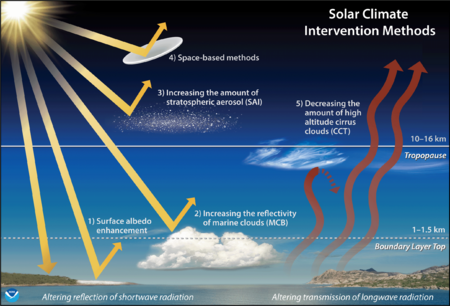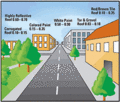Solar geoengineering facts for kids
Solar geoengineering, or solar radiation modification (SRM), is a type of climate engineering in which sunlight (solar radiation) would be reflected back to outer space to limit or offset human-caused climate change. Solar geoengineering is not a substitute for reducing greenhouse gas emissions but would act as a temporary measure to limit warming while emissions of greenhouse gases are reduced and carbon dioxide is removed.
If solar geoengineering were to cease while greenhouse gas levels remained high, it would lead to "large and extremely rapid" warming and similarly abrupt changes to the water cycle. Rapid termination would significantly increase the threats to biodiversity from climate change. In spite of this risk, solar geoengineering is frequently discussed as a policy option because it is much faster and (in the short run) cheaper than any form of climate change mitigation.
Governing solar geoengineering is challenging for multiple reasons, including that few countries would likely be capable of doing it alone. For now, there is no formal international framework designed to regulate SRM, with aspects of the UN Convention on Biological Diversity or the Vienna Convention for the Protection of the Ozone Layer coming the closest out of the existing agreements. Thus, many questions regarding the acceptable deployment of SRM, or even its research and development, are currently unanswered.

Solar geoengineering methods include:
- Stratospheric aerosol injection, or SAI, in which small particles of e.g., sulfur dioxide would be injected into the upper atmosphere.
- Marine cloud brightening (MCB), which would spray fine sea water to whiten clouds and thus increase cloud reflectivity.
- Cirrus cloud thinning (CCT), which is strictly not solar geoengineering but shares many of the physical and especially governance characteristics as the other methods.
More recently, research began exploring alternatives like using SRM as an aid to avoid failing the Paris Agreement goals of 1.5 °C (2.7 °F) and 2 °C (3.6 °F). It has also been suggested that SRM is deployed to halve the current warming, as this may be less disruptive to societies and ecosystems than attempting to reach the preindustrial levels. However, this approach may also increase flood and wildfire risk in Europe. There have also been proposals to focus the use of SRM at the poles, in order to combat polar amplification of warming and the associated Arctic sea ice decline, permafrost thaw and ice sheet melt leading to increased sea level rise. However, actual deployment of even the cheapest proposals is projected to cost tens of billions of US dollars annually, so the decision to deploy these interventions would not be taken lightly.
Contents
Evidence of effectiveness and impacts

Research has shown that a moderate magnitude of solar geoengineering could bring important aspects of the climate - for example, average and extreme temperature, water availability, cyclone intensity - closer to their preindustrial values.
The cooling caused by SRM could increase the global land and ocean CO2 sinks. However, this would not stop CO2 from increasing in the atmosphere. Scientists believe that a sudden termination of SRM could cause rapid climate change.
Greenhouse gases warm the entire planet and are expected to change precipitation patterns, with an overall increase in precipitation. Models indicate that solar geoengineering would compensate these changes. Some researchers claim that SRM might cause drought, but this would depend on the intensity (i.e. radiative forcing) of solar geoengineering.
Understanding of solar geoengineering's effects on ecosystems remains at an early stage.
Advantages
The target of net zero greenhouse gas emissions can be achieved through a combination of emission cuts and carbon dioxide removal, after which global warming stops, but the temperature will only go back down if we remove more carbon dioxide than we emit. Solar geoengineering on the other hand could cool the planet within months after deployment, thus can act to reduce climate risk while we cut emissions and scale up carbon dioxide removal. Stratospheric aerosol injection is expected to have low direct financial costs of implementation, relative to the expected costs of both unabated climate change and aggressive mitigation. Finally, the direct climatic effects of solar geoengineering are reversible within short timescales.
Limitations and risks
Most of the information on solar geoengineering comes from climate models and volcanic eruptions, which are both imperfect analogues of stratospheric aerosol injection. Modelling is uncertain as little practical research has been done.
Maintenance and termination shock
Solar geoengineering effects would be temporary, and thus long-term climate restoration would rely on long-term deployment until sufficient carbon dioxide is removed. If solar geoengineering masked significant warming, stopped abruptly, and was not resumed within a year or so, the climate would rapidly warm. Global temperatures would rapidly rise towards levels which would have existed without the use of solar geoengineering. The rapid rise in temperature might lead to more severe consequences than a gradual rise of the same magnitude.
Some claim that solar geoengineering "would basically be impossible to stop." This is true only of a long-term deployment strategy. A short-term, temporary strategy would limit implementation to decades.
Disagreement and control
Although climate models of solar geoengineering rely on some optimal or consistent implementation, leaders of countries and other actors may disagree as to whether, how, and to what degree solar geoengineering be used.
Unwanted or premature use
There is a risk that countries may start using solar geoengineering without proper precaution or research. Many countries have the financial and technical resources to undertake solar geoengineering.
Distribution of effects
Both climate change and solar geoengineering would affect various groups of people differently. Some observers describe solar geoengineering as necessarily creating "winners and losers." However, models indicate that solar geoengineering at a moderate intensity would return important climatic values of almost all regions of the planet closer to preindustrial conditions.
Developing countries are particularly important, as they are more vulnerable to climate change. All else equal, they therefore have the most to gain from a judicious use of solar geoengineering.
Lessened mitigation
The existence of solar geoengineering may reduce the political and social impetus for mitigation. This has generally been called a potential "moral hazard," although risk compensation may be a more accurate term. This concern causes many environmental groups and campaigners to be reluctant to advocate or discuss solar geoengineering.
Effect on sky and clouds
Managing solar radiation using aerosols or cloud cover would involve changing the ratio between direct and indirect solar radiation. As a result, deployment of atmospheric solar geoengineering would reduce by at least 2-5% the growth rates of phytoplankton, trees, and crops between now and the end of the century.
Images for kids
-
Potential complementary responses to climate change: greenhouse gas emissions abatement, carbon dioxide removal, solar geoengineering, and adaptation. Originally called the "napkin diagram" and drawn by John Shepherd.
-
Change in sea surface pH caused by anthropogenic CO2 between the 1700s and the 1990s. This ocean acidification will still be a major problem unless atmospheric CO2 is reduced.
-
The albedo of several types of roofs (lower = hotter)
See also
 In Spanish: Geoingeniería solar para niños
In Spanish: Geoingeniería solar para niños
- Climate engineering
- Cloud seeding
- Passive daytime radiative cooling
- Weather Modification Operations and Research Board







